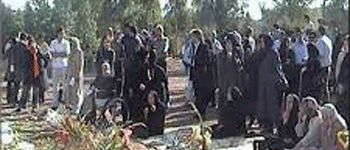 On the last Friday of the ending Iranian year people were prevented from gathering at the Khavaran cemetery on the outskirts of Tehran to pay homage to the victims of the 1988 massacre of political prisoners by the Iranian regime – as well as those killed by the Iranian regime in the 1980s, the National Council of Resistance of Iran (NCRI) reported.
On the last Friday of the ending Iranian year people were prevented from gathering at the Khavaran cemetery on the outskirts of Tehran to pay homage to the victims of the 1988 massacre of political prisoners by the Iranian regime – as well as those killed by the Iranian regime in the 1980s, the National Council of Resistance of Iran (NCRI) reported.
Comprised mostly of the members of the victim’s families, their relatives and friends, the crowd traditionally pays their respects, light candles and say a brief prayer before returning to their homes. Yet, this year the Iranian regime decreed that this peaceful procession was unacceptable.
The state security forces and agents of the Iranian regime’s Ministry of Intelligence and Security prevented the families from holding the gathering. The forces blocked the road leading to the cemetery, cordoned of nearby areas and harassed the people intending to attend the gathering – mostly women and children.
It seems that the regime is trying to suppress all memory of its atrocious acts in 1988.
In the summer of that year, the regime summarily, extra judicially and completely abandoning all rules of legal due process executed tens of thousands of political prisoners held in jails across Iran. Up to this date the regime has never acknowledged the executions, despite a wide array of evidential sources exposing its acts.
Because of this secrecy, limited information exists on the identity of the prisoners or the number of people executed. The majority of those executed were either serving prison sentences for their political activities – usually on trumped up charges – or had already finished their sentences but were still kept in prison.
Some of the political prisoners had previously been imprisoned, had served their sentence and had been released, but were again arrested and executed during the massacre.
The widespread spate of killings of political prisoners began in late July 1988 and continued unabated for the whole summer. By the time it stopped in fall, thousands of political prisoners – the overwhelming majority belonging to the People’s Mojahedin Organization of Iran (PMOI/MEK) – had been mercilessly killed.
Mohammed Nourizad, former Cultural Advisor to the regime’s Supreme Leader, revealed last year that more than 33,000 people where executed during the massacre of 1988. His revelations came after he had turned against the Supreme Leader after the regime brutally suppressed the 2009 anti-regime protests.
In a statement issued on November 2nd 2007, Amnesty International wrote, “The executions were authorized at the highest level of the Iranian leadership… Amnesty International believes these executions amount to a crime against humanity.
Under international law, valid in 1988, crimes against humanity consist of widespread or systematic attacks against civilians on discriminatory, including political, grounds. Amnesty International believes that there should be no impunity for human rights violations, no matter where or when they took place.
The 1988 executions should be subject to an independent impartial investigation, and all those responsible should be brought to justice, and receive appropriate penalties.”







